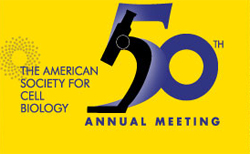 Cell biologists, including many of our funded investigators and a few of us from NIGMS, were in a celebratory mood as the 50th Annual Meeting of the American Society for Cell Biology kicked off December 11 at the Philadelphia Convention Center. The keynote symposium began with Gary Borisy’s description of the first ASCB meeting, when Hans Ris described his then-heretical finding that chloroplasts contain DNA. For more details about the genesis and early years of the ASCB, check out John Fleishman’s article, A Place of Our Own, in the December 2010 ASCB Newsletter.
Cell biologists, including many of our funded investigators and a few of us from NIGMS, were in a celebratory mood as the 50th Annual Meeting of the American Society for Cell Biology kicked off December 11 at the Philadelphia Convention Center. The keynote symposium began with Gary Borisy’s description of the first ASCB meeting, when Hans Ris described his then-heretical finding that chloroplasts contain DNA. For more details about the genesis and early years of the ASCB, check out John Fleishman’s article, A Place of Our Own, in the December 2010 ASCB Newsletter.
An exciting addition to this year’s meeting was the science discussion table format. Eminent researchers sat at tables for an hour at the beginning of each poster session and took questions from relative newcomers to the field. I stopped by to say hello to some of the NIGMS-supported investigators in my grant portfolio, but each table was crowded with graduate students and postdocs eager to discuss science and seek advice from their fields’ leaders. Two thoughts came to mind as I watched the scene unfold: I wish that there had been these tables when I was a young scientist, and I hope this format becomes a regular feature of the ASCB meeting.
While science is the major focus of the ASCB meeting, education, mentoring and career development also are important features. A number of education workshops focused on topics such as pedagogy, science literacy and online teaching resources. Women in Cell Biology-sponsored events focused on careers, mentoring and managing life as a scientist. In addition, NIH program and review staff answered questions about the grant process. I was one of them, and my favorite part was talking to postdocs and investigators I know from phone calls and e-mail exchanges.
I saw a number of outstanding talks and posters at the meeting, and to say that there is not enough room here to mention them all is an understatement. I was particularly intrigued by presentations from Ron Vale’s lab at University of California, San Francisco, on the cytoplasmic dynein motor domain at 6 Å resolution and from Tom Schwarz at Harvard Medical School on identifying a role for Parkinson’s disease-associated proteins in the regulation of mitochondrial transport within axons. As someone interested in intracellular transport, both presentations offered answers to long-standing problems in cell biology and provided a launching pad for testing new ideas about how organelles move to specific cellular destinations.
I’m already looking forward to the 2011 meeting in Denver.


We at ASCB are so pleased that Joe Gindhart and so many others enjoyed the ASCB’s 50th Annual Meeting and appreciated the new science discussion tables, and other scientific, career development-and education- focused activities. We’re grateful for Joe’s participation and NIH support and plan to continue these activities at the 51st ASCB Annual Meeting in Denver, CO, Dec. 3-7, 2011. See you there!